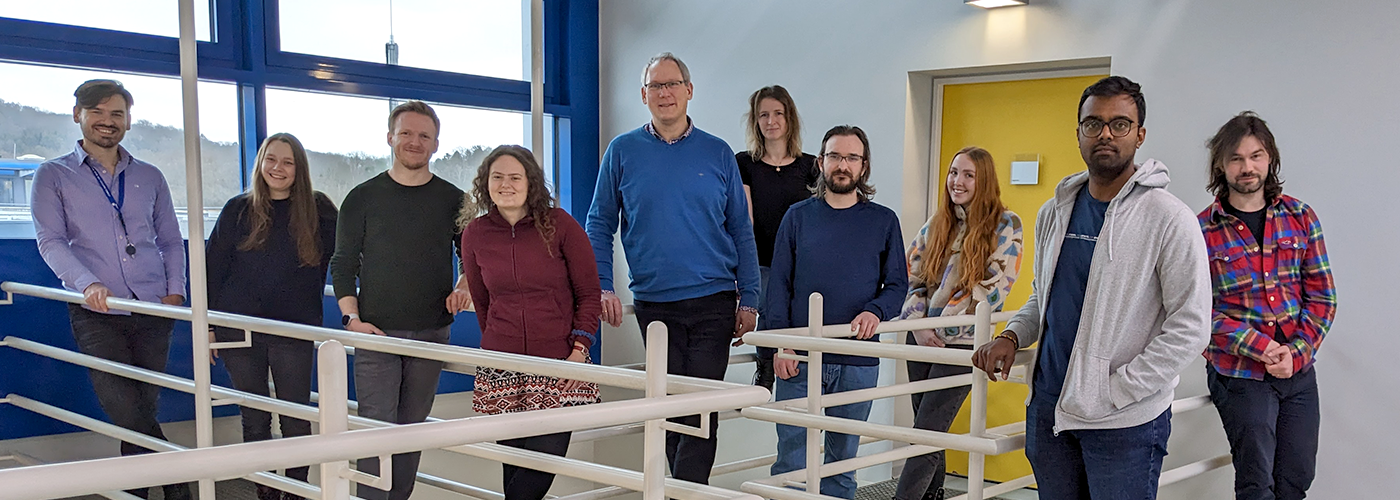Our research department studies the mechanical properties of materials with a focus on surfaces. We aim to understand mechanisms of adhesion, friction, and wear through innovative experiments and to contribute to the design of new materials with mechanical functions. Example projects address the contact mechanics of novel lubricants, the nanomechanics of biomaterials, and the tactile perception of micro-structured materials.

Team Members
Research
Molecular mechanics of soft matter
We use high-resolution force microscopy (AFM) in aqueous solution to study molecular forces at the surface of soft matter. Single-molecule force spectroscopy on hydrogels contributes to the understanding and control of the mechanisms of bioadhesion and mechanotransduction on biomaterials. In active materials, we employ light-activated molecular motors for the mechanical stimulation. For rapid force measurements on the single-molecular level, we develop novel high-throughput techniques based on tethered-particle motion in microfluidic devices.
Relevant publications:
- B. Li, A. Çolak et al.,
Molecular stiffness cues of an interpenetrating network hydrogel for cell adhesion
Materials Today Bio, 15 (2022) 100323. - Y. Zheng, M.K.L. Han, R. Zhao, J. Blass, et al.,
Optoregulated force application to cellular receptors using molecular motors
Nature Communications, 12 (2021) 3580. - M. Penth et al.,
Nanomechanics of self-assembled DNA building blocks
Nanoscale, 13 (2021) 9371-9380. - Colak, B. Li, et al.,
The mechanics of single cross-links which mediate cell attachment at a hydrogel surface
Nanoscale, 11 (2019) 11596-11604.
Nanotribology
Friction force microscopy in ultra-high vacuum or in aqueous solutions reveals molecular mechanisms of friction. As one example, we investigate the limits of superlubricity in 2D materials under high local pressure. We also move our research towards a nanotribology of hydrogels and study dissipative interactions of single fluctuating polymers.
Relevant publications:
- B. Szczefanowicz, et al.,
Formation of intermittent covalent bonds at high contact pressure limits superlow friction on epitaxial graphene,
Physical Review Research, 5 (2023) L012049. - K. Schellnhuber et al.,
Single-Polymer Friction Force Microscopy of dsDNA Interacting with a Nanoporous Membrane,
Langmuir, 40 (2024) 968-974. - Z. Liu et al.,
Nanoscale friction on MoS2/graphene heterostructures,
Nanoscale, 15 (2023) 5809-5815.
Tactile perception of materials
Fingertip friction plays a key role in the tactile exploration of materials and in the perception of material properties and surfaces structures. We implement psychophysical studies to find correlations between fingertip friction and individual judgement on touch of materials.
Relevant publications:
- R. Sahli et al.,
Tactile perception of randomly rough surfaces
Scientific Reports, 10 (2020) 15800. - Gedsun et al.,
Bending as Key Mechanism in the Tactile Perception of Fibrillar Surfaces
Advanced Materials Interfaces, 9 (2022) 2101380. - M. Fehlberg et al.,
Perception of Friction in Tactile Exploration of Micro-structured Rubber Samples,
in Haptics: Science, Technology, Applications, Springer 2022, pp. 21-29.
Materials for the future of tactile communication
Materials with switchable surface structure offer opportunities to quickly convey information to humans by varying the touch experience. We develop micro-structured elastomers which change the surface shape by applied electric fields or pneumatic mechanisms. The sensory reaction to such stimulation of touch is evaluated by EEG and MEG experiments.
Relevant publications:
Publications
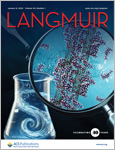
Schellnhuber, Kordula | Blass, Johanna | Hübner, Hanna | Gallei, Markus | Bennewitz, Roland
Langmuir , 2024, 40 (1), 968-974.
https://pubs.acs.org/doi/10.1021/acs.langmuir.3c03190
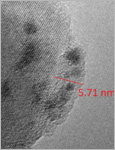
Szczefanowicz, Bartosz | Kuwahara, Takuya | Filleter, Tobin | Klemenz, Andreas | Mayrhofer, Leonhard | Bennewitz, Roland | Moseler, Michael
2023, 5 (1), L012049.
https://doi.org/10.1103/PhysRevResearch.5.L012049
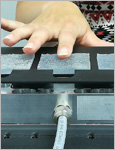
Sahli, Riad | Prot, Aubin | Wang, Anle | Müser, Martin H. | Piovarči, Michal | Didyk, Piotr | Bennewitz, Roland
Scientific Reports , 2020, 10 (1), 15800.
https://doi.org/10.1038/s41598-020-72890-y
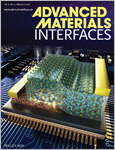
Gedsun, Angelika | Sahli, Riad | Meng, Xing | Hensel, René | Bennewitz, Roland
Advanced Materials Interfaces , 2022, 9 (4), 2101380.
https://onlinelibrary.wiley.com/doi/abs/10.1002/admi.202101380
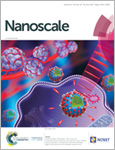
Çolak, Arzu | Li, Bin | Blass, Johanna | Koynov, Kaloian | del Campo, Aranzazu | Bennewitz, Roland
Nanoscale , 2019, 11 (24), 11596–11604.
http://dx.doi.org/10.1039/C9NR01784D

